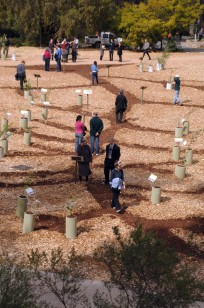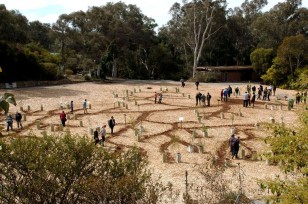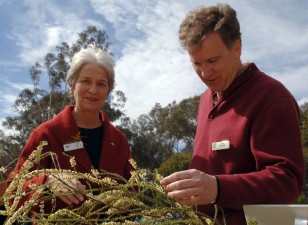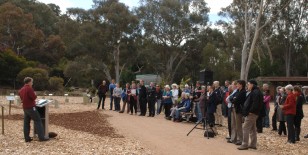By Robyn Lawrence, Atlas of Living Australia
The Atlas of Living Australia is one of the proud sponsors of the Acacia Tree of Trees exhibit held at the “old nursery” site in the Australian National Botanic Gardens, Canberra.
The Executive Director of the Australian National Botanic Gardens, Dr Judy West, opened the Tree of Trees exhibit to celebrate National Wattle Day, held each year on the 1st of September.
Acacia, commonly known as wattles, are the richest plant genus within the Australian flora. Their typical yellow flowers, although not all Acacia flowers are yellow, is an iconic sight across most Australian landscapes and the genus is well recognised by most Australians.
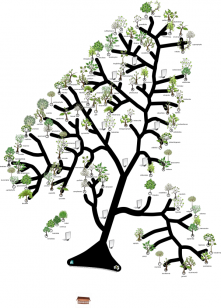
The trunk and branches are paths that can be explored to reach the groups of plants with similar genetic profiles. Comparisons can be made between closely related species and those located on other branches within the Tree of Trees
(press to see high resolution image 3MB)
Botanist and molecular systematist, Dr Joe Miller, designed the evolutionary tree of Acacia, with 100 different species arranged as the leaves of the tree. The phylogenetic tree shows the similarity or dissimilarity between the 100 Acacia species documented to date. The closer the plants are together on the branches of the tree indicate the similarity in their genetic relationship, while plants on different branches indicate less similarity in their genetic makeup. This display allows visitors to examine specimens of the plants with their nearest related ancestors. It allows the public to view similarities in structure and design in relation to their genetic relationships.
“This display shows how data drawn from the Atlas can be used in innovative ways. It’s great to see the on-ground relationships between species of plants in such an iconic Australian genus”, said John Tann, Team Leader for Collections Data Management of the Atlas.
The Tree of Trees exhibit currently documents around 10 percent of Australia’s known Acacia species. The Botanic Gardens and Centre for Plant Biodiversity Research staff grew the plants used in the layout and put together this model of over 2000 square metres. All up, the exhibit has 360 linear metres of path to traverse, made from 17 cubic metres of tan bark.
The Tree of Trees exhibit reflects a long-term DNA sequencing study carried out by the Centre for Plant Biodiversity Research, a joint venture between the Australian National Botanic Gardens and CSIRO Plant Industry. The Atlas of Living Australia amalgamated and provided the species information and distribution maps for the panels in front of each plant, allowing the public to gain greater insight into the species data associated with the each of the display plants.
The display will be available to the public at the Australian National Botanic Gardens until the 25th October 2010.
For more information
- Australian National Botanic Gardens website
- The Centre for Plant Biodiversity Research website
- Australian National Botanic Gardens, old nursery site for the Tree of Trees exhibit
- Acacia Tree of Trees details (1 Sep – 25 Oct 2010)
- Australian National Botanic Gardens (ANBG) / Centre for Plant Biodiversity Research (CPBR) media release
- Genus Acacia information
- World Wide Wattle site
All photos courtesy of Carl Davies, Visual Resources Unit, CSIRO Plant Industry
